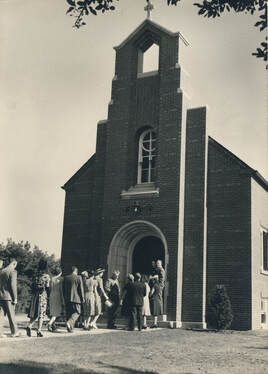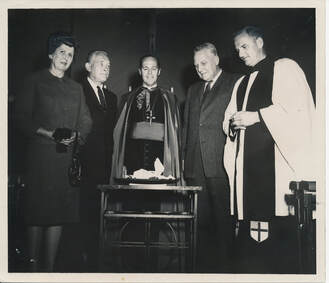The first church services ever held in the Village of Flossmoor were those held under the auspices of The Episcopal Church. In the 1920s, Homewood was just beginning to be a town, and Flossmoor was a tiny Village. Only a few of the residents were Episcopalians. Prompted by their need for an Episcopal Church, this small group banded together and sought assistance from the Reverend Edwin J. Randall, Executive Secretary of the Diocese of Chicago (and later Suffragan Bishop of Chicago). In November of 1926, Father Randall started holding monthly services in the Flossmoor Public School (later known as Leavitt Avenue School, located across the street from the current Church where Leavitt Park is now located). In 1929, St. John's was formally recognized by the annual Convention of the Diocese of Chicago as an organized mission.
The first spiritual leader of St. John's Mission was a seminarian, E. A. Drake. He was followed by another seminarian, J. W. Kennedy. By 1931 an active Church School had been established and the mission began to thrive and the first fulltime Priest-in-Charge was appointed, The Reverend William D. McLean. Having outgrown space in the Flossmoor Public School, services were moved to the Flossmoor Civic Center Building with the first service in this location being held on Christmas Eve, 1931.
Between 1931 and 1935, St. John's Mission was served by two Priests-in-Charge, the Reverend James E. Charles and the Reverend Rex C. Simms. Father Simms remained at St. John's until 1935 during which time the mission moved to a permanent location in the Civic Center Building which later became St. Mary's Thrift Shop. The St. John's Community worshiped in this location until the completion of the present church building located at the corner of Park Drive and Leavitt Avenue.
Between 1935 and 1946, the mission was led by several Priests-in-Charge, including the Reverend Wilford O. Cross (1935), the Reverend John C. Evans (1937), the Reverend Richard L. Sonne, and the Reverend Ralph J. Spinner.
During the war years, all plans for building a permanent church were put on hold, however the congregation continued to thrive. By the time Father Spinner left St. John's Mission in 1946, plans for a new church building had been drawn up.
The Reverend John E. G. Griffiths was appointed Priest-in-Charge in 1946. Under his direction the present building was completed in 1947 at a cost of $86,000 plus furnishings. The mission had grown to forty families (seventy registered communicants) by this time. At the Annual Convention of the Diocese of Chicago in 1947, the mission was admitted to the Diocese as a parish, The Episcopal Church of St. John the Evangelist. The first Vestry was organized and Father Griffiths was installed as the first Rector of the new Parish.
As the church was nearing completion, the women of the St. Mary's Guild held a rummage sale to help raise money for the building fund. The sale, and a second one soon after, were so successful that the Guild established a permanent thrift shop in the newly vacant store front where the church had been worshiping. Appropriately named St. Mary's Thrift Shop, this ministry played a leading role in paying off the church mortgage in only sixteen years.
By 1949, St. John the Evangelist had grown to 88 families (110 communicants) and phase 2 of the building program had been completed: the rectory and cloister were built at a cost of $36,000 plus furnishings.
In 1951 the Vestry called the Reverend James Winchester Montgomery to serve as the second Rector of the Parish. Under his guidance the Parish grew rapidly. In 1955 the third phase of the building program - the Church School building (now known as the Education Wing) - was completed at a cost of $85,000 plus furnishings, which provided much needed space for children's religious education. The Parish now numbered 222 families and in 1958 the church was enlarged by pushing the altar wall back and adding the east and west transepts at a cost of $84,000. A year later the building connecting the church and church school building was completed at a cost of $65,000, which provided space for the Guild Room, Nursery, Church School office, and the Curate's apartment. The Parish now numbered 390 families.




